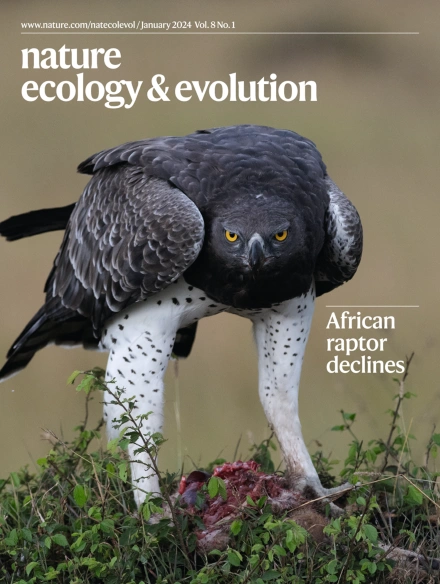多物种迁徙连通性表明全球变化给鸟类种群带来的半球尺度风险
IF 13.9
1区 生物学
Q1 ECOLOGY
引用次数: 0
摘要
减少迁徙物种灭绝风险的全球协议主要依赖于交叉的迁徙连通性——不同季节地区之间个体的联系——以及环境变化的空间模式。本文综合了112种329,000只候鸟的迁徙数据,建立了一个反映全球变化的参数:多物种迁徙连通性。然后,我们将暴露与预测的气候和土地覆盖变化结合起来,作为危害的衡量标准,并将物种保护评估分数作为脆弱性的衡量标准,以估计整个西半球候鸟种群数量下降的相对风险。相对于危害和脆弱性而言,多物种迁徙连通性(暴露)是风险的最大驱动因素,表明综合跨物种连通性对综合评估风险的重要性。加拿大的繁殖区和南美洲的非繁殖区之间的联系面临着最大的风险,这强调了长途移民的特别易感性。超过一半(54%)被归类为非常高风险的联系包括美国东部的繁殖区。这个由三部分组成的框架是专门为候鸟设计的生态风险评估,为全球生物多样性保护提供决策支持,并为维持候鸟种群全年的政府间合作提供机会。本文章由计算机程序翻译,如有差异,请以英文原文为准。


Multispecies migratory connectivity indicates hemispheric-scale risk to bird populations from global change
Global agreements to reduce the extinction risk of migratory species depend critically on intersecting migratory connectivity—the linking of individuals between regions in different seasons—and spatial patterns of environmental change. Here we integrate movement data from >329,000 migratory birds of 112 species to develop a parameter representing exposure to global change: multispecies migratory connectivity. We then combine exposure with projected climate and land-cover changes as a measure of hazard and species conservation assessment scores as a metric of vulnerability to estimate the relative risk of migratory bird population declines across the Western Hemisphere. Multispecies migratory connectivity (exposure) is the strongest driver of risk relative to hazard and vulnerability, indicating the importance of synthesizing connectivity across species to comprehensively assess risk. Connections between breeding regions in Canada and non-breeding regions in South America are at the greatest risk, which underscores the particular susceptibility of long-distance migrants. Over half (54%) of the connections categorized as very high risk include breeding regions in the eastern United States. This three-part framework serves as an ecological risk assessment designed specifically for migratory species, providing both decision support for global biodiversity conservation and opportunities for intergovernmental collaboration to sustain migratory bird populations year-round. On the basis of data from >329,000 migratory birds, this study presents multispecies migratory connectivity as a parameter representing exposure to global change and shows that connections between breeding regions in Canada and non-breeding regions in South America are at greatest risk from global change.
求助全文
通过发布文献求助,成功后即可免费获取论文全文。
去求助
来源期刊

Nature ecology & evolution
Agricultural and Biological Sciences-Ecology, Evolution, Behavior and Systematics
CiteScore
22.20
自引率
2.40%
发文量
282
期刊介绍:
Nature Ecology & Evolution is interested in the full spectrum of ecological and evolutionary biology, encompassing approaches at the molecular, organismal, population, community and ecosystem levels, as well as relevant parts of the social sciences. Nature Ecology & Evolution provides a place where all researchers and policymakers interested in all aspects of life's diversity can come together to learn about the most accomplished and significant advances in the field and to discuss topical issues. An online-only monthly journal, our broad scope ensures that the research published reaches the widest possible audience of scientists.
 求助内容:
求助内容: 应助结果提醒方式:
应助结果提醒方式:


